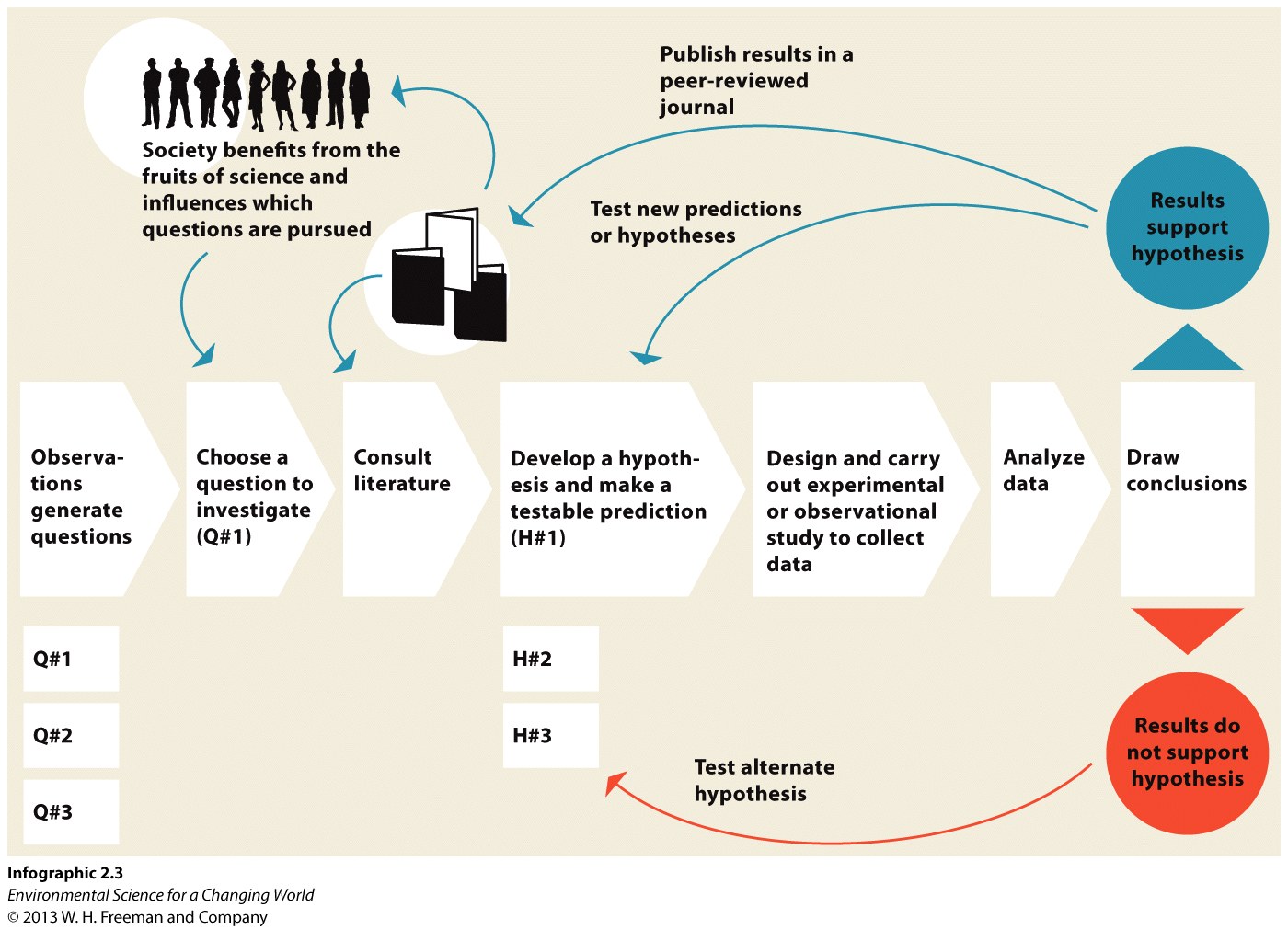Chapter 1. The Goby Mystery
Introduction
The Goby Mystery

Click the Next button to start this activity
1.1 The Benguela Ecosystem
Off the coast of Namibia, upwelling occurs from a deep ocean current. This area is the Benguela ecosystem. Prior to the 1960's, this area was heavily fished by humans. In fact, humans took so many fish (primarily sardines) that the entire fishery collapsed, and commercial fishing has been severely limited ever since. Once the fish were gone, jellies invaded and the area now contains enormous quantities of jellies and not many fish.

1.2 The Benguela Ecosystem
Scientists studying the area were surprised to find that one fish remains, a bottom dweller named the bearded goby. The mud off the Namibian coast contains large amounts of hydrogen sulfide, which is poisonous. Further, the sediments are anaerobic.

1.3 The Surprising Goby
Review the scientific process.

Question
0Gk0dtFVr11OJxfdooA5HzSzs8CuuH/cDLC3IY08tmEzI4w44KVVzbwvufBCfY+dsn74bblPQdgleTfjOOfXawj5EmD8Htw/KN5KDwn9902FHfSfBlI+eFfGrhIOHj11ZnT8F9t5dtCsz8Yl7CXc5/S6tjJMzCh1h44gqtOpluwCJeIkSlltd0f0ETWwsqbWbTj9/SP7F/6LdNljAqhgDPH3EPBUsba7SN0zRWyf26TaS79lZ2xmCGOzy5ab7ff7SW3GqNjnHlP9mhx4XCBHfKcJt4fzKd5tr2Tgg7tZ1BHdCpP2Ukl+0ZtC9Wnvvl7gMgcXdXRWNi4sV+oNUAk0KKjYfWVuW2HdfQ4xeywnEcA/HqVDFpUoQYr2OrsnPiaDHI7bG/D1AUORusCKgzGUsPsNDjIGx06Ugd5HT0c4iUBPfIY8kuVJB6YDrkUCHHdcBCkkOFFXS+EnjTVWAbBuxqdEfwdpNVVfzdUk/hYPHFG/9Q2P5cEHUZ3eCMOjHEPo/0f7L6a3WT7+tYjD/qRvdCGzvIdi9ooqyJzTu70a+rX0cQC5NJbi5/Cm233PV0J8aCSx4mSU0QpYGkuP2PmfkMmUGGbjUgbJCVFwTZfno+R0VXCnl4md7961wi3AdTbxuZbm64MO8vk=1.4 The Surprising Goby
When scientists initially noticed the gobies, they thought perhaps they were dying. But the fish showed an appropriate anti-predator response, and seemed alert and healthy. To scientists, these fish presented a mystery. How could they live on a toxic, unoxygenated ocean floor? What was it that allowed them to survive where other fish couldn't?
In this tutorial, we will uncover the mystery of the bearded goby using the scientific process. You will practice each step and compare your results to those of the scientists, and reach a surprising conclusion.

1.5 Questions lead to experiments
Question
B4kOuqkB2n+9dIL/Tc8z0UBWQfQxzwdPH+DkTAz73n4J5taHdLl/+qf3jfsy0ro0DV75uUEW18EEqs/zZ3Ok0KLPgSRFA4qLbBUgdbsgt99xZq9Fxb/2ZwR5Qay5lncWC1NQZ0vnp0tOLNv4nStMYVEPa2a5s+Q7sSeQ+iWPJ1ni00JG13tA8IlZGSl+h+0Y9ifuUfqxe62MK4jFWrl+SuwkX+02hopDQlyJNCY62l04P0K3mqDhScUuqb92N/KQ2MZyRfmeV9Cum2SdxWbdZau43jJwIG/0bTjeudNRVb662WLXEqZXo8IBCzVz/pXS48WAjxrwS+UC7EAMetWoKqhUTCEx8FElByRbe4voM32hEGQf9QUQ6jvK8gFLtXzfD2cV7OpNXpQYgdKaTwJo6XQzNGusxIY1dITt2vGxzxh6vyv8qKKXvrcSuiOta5IVTYTsAP3whq2c+bcsiJjZBUdEPa+8MZgUKOksa0Ye6g537PRNL5CZ9grHfAIIrU6o8QxesrThNgZw75hmkbwu39cGIPvXbWOgGRJ//f6ILWrebKz3JSxp6KVpcqz+2ur4qkvrSbtCj2UXJsYq1.6 Questions lead to experiments
Question
AOWCxVXwTRqgFGOr+FEsy/r7Sp7FXiTl2z/wxZMRsGgcz+uT6S4ZKTAcyuEYvNSJjQ+bPZYQV6ud/ji9hDNXffxaThurqu4NCGxN612zUhCeTGxEClzPxxiFgzrODV8OXUg/5i5inPJVnvhgdNPegaTyFgFPrVT41qek1t69flP+/6cY12vGzmleLZQZaRVJq9wiuVcSfcea1DdkgJnOp3eBF6/iffXI6VCmFSObgkWbDbhH8sDplNjmNzROsCOvVch/vlxLwRq/E7HXuA3BXeDbtCqqBkcbJopMmPgJAd91Jb1rgBTB3HF6gX/ZyXF4jWdPzA4NVcDSchvfcaXwlB1KWwuJg7+lX5QcP8syG9CH3T3I6tQwTRPIs82Mlrtn9GAZcn3si7xkUW7ARHqGHdHbH4TXz6QDk3y4JSEaFCQzUm1wppRdUiLsY46Tv1AYHNU0cm9hFeRSjoZ1QDpUAnEm+t1dxqFjczafIqxYo27zpB0tsjCplorYZIZiBdS2j5kXaiJO+QB4KvqsM6Ub+KffIl9vFh3Bq1WV3rIw1gR0I5lvF34DFFKsxg2DGJB/ftkFUPR63/ZihybX6xMl0PLY4IPc2/fJIbkXkGEEdurO3cyExPlBKBFiE8GPbeycdf80hfPZ56UMaO+Cs2IOI0ITJWlXuKeuCp6UJMGcrGIVQD6OzkRC0KSUSA8gXx9/j28gNkELXUL18tZnWHv/otEd75PESrPYxEPrSDF9Yx+Z64iD+pvmAGLJbRQ9GNwIgDcny4AUoKl9z6kA/1XDOezdGuGdBMAM2bPqvuzGoxSeaI1KamTTSn+QWYQoXcmIRE0AY4OPD6IeNOwoo1ub8uHZS/bCIpQb4OOZHgqykmAOyKHCdRDkxwWP/144EBN2Ab/8tVR4QMaOEAeZuUXM8xhlT4Fbiix3Ev9zWQA3k/umUdmKjz1jocIvZ9c5qHKF5Azs1FKBskBB3ltTM7JPzcYfyW3Wo9SCt8jX4cR58urVaf30PXMJsszevF/WN/ljXlEd9dnqGTVgymfiHtKiReXaRAfK63kj78v/KMwzmwtCuCWQ3vG36b74Xr4Zqs9mESt+YhdqxpUtJyUQSAX2aEBHJoV9/kkdf5yf/PbChDczMLiq435mXGeq8x+/3yGnrfcSHda075Gz2WPn3tGkguq5pXtLksMA51HkzF1lG+beO4D1H6dcXuJOQhW1IwCST2AK/IW9nV4WLNpuIHkB1/DbqfASLyLetzFjxjtUdKorXzpbXIf3KE4KfOlVtUv7gTj3R9TpvgqlPYAYHzQmvKvMpAiezKI/Nf7SlJ1eEIVdCg1w89dvBOfmBNUVFjKHIzzRByF4ybezbccoTyGPt8p12W2XC3AvVTbb/YuIZ+xo1eEE0RdVgrEnA9BcOlY1yxpJMqAwnOxQa+EpT+9ANXlZqXxwvo95OW5eZn8djakyjodN29JBTOqFkzMyThOAJqLAm03YDLg=1.7 Questions lead to more questions
The researchers also determined (in lab experiments) that the gobies could sit in the mud safely because they stop pumping water and oxygen over their gills, the fish equivalent of holding their breath. But why were the fish hanging out on the bottom at all?
Hypothesis 1: They were feeding on the bottom
Question
aor/hFeqQYepnlexrYbTclhfBD8KuZx2ISKqvTPT1JPwxjQez5YZW4G46Woa7J71mlhnA3Zetvwtli+HY9GkZeAEA4Nn580D/PmQMnjjeBmXedmsOrrFbUd0Xu2R/rZxTYOYa9sBR0GycjjxP0FnnG0FdW5U1QQGcdyxGWu6127mlM1vaYdYpiCHgNWkguiO0d2l8yzZXc/GDN894kV82ZA4NIRW/pkwhhqTx1Cgrxzs7gXBseib1nd7d9F9X8/RZmO3Xv2Q/2Z38EkZTjzcr7AoX5Mg482dUuDLWH8pdXiwsrTq/9NGdkgxXwzuuNryhURszEbX2CGrPQqknvli2xFet/R3W5HtkWxBkWUwI6NY4B+aa+3Tv7nhnGg5aeeI2KKEm6T7b3fvaAf2gIMwrps+UF10LXgd8rH6oOXl3w9NAb1yEWgPFQGANWIjE44HfSrw6QOz1j3rKr2wUnHuoqmrUu6OOw+2jfJpMY7z0nyVcNhFFEQSX2UaWGYh1cNV+ghlXxGJP9Jwj/a/W1o31YCqFlnN0qPEex/boPOg8GdXH4SGYJyfljMMYumgOptOqMPIoXWduTYNiCaXx5Dchz7vZ1/QH98gw1xuVp3lZObe5H/QCUaFZGf171BbTtUOi7c7iwCRLVEZvTJ04ZA5V4FMr9qQZrPt8pCbCRnSeM2GE/fqh53kDeli3+4uvTfi3BiLD/5g9/2lb8BrvqzlbZV1kUUwavdHjE/ezWUoTL4oc002jX0FRm3HbP0kiwtSW0iDLwR1TDMUxrSxQ83eupzsFQUnagcR94uv2jxycKIDLDDFGPJlmNEHsmdkIGarMESP45dUqvcpFLakEYrBuD0yxMDMgmr04T2E9oYJT/LqBpiddeTong==1.8 Questions lead to more questions
Researchers had a second hypothesis to explain the gobies presence on the ocean floor.

Hypothesis 2: The gobies are avoiding predators during the day, and swimming up in the water column at night to oxygenate when they are less obvious to predators.
http://b.vimeocdn.com/ts/121/813/121813798_200.jpg
1.9 Testing Hypotheses
Using sonar, the researchers tracked the movements of the gobies throughout a 24 period.

1.10 Testing Hypotheses
Question
XI734wYJEYW0V+tecpg+W7GAd0XmNSGEteSxX0DEQp48e1ADySGUuERkTc9VEwK1yklyHeOncnoJmqUSWtO0KLI1rFnbIDEcrBuhoa420LnBhWfOyPG5DiwvPR66hy9ZRE5P9FPL4eh/QF5Rt+FKk/8+rGC1wV6K7UGvTHwCRPBko4Pq393q8x2S8Lza0fKM9GCOXLEpKyuvRg4i5tqEqEDaPs7QzGzC85w6Y1HBgGdKChdDyKh0WovyH01eKpolpAfkpAIguP3rCdybO4UeYrwTrDV6l62Tb7f0HqM6jMANk62kelLqvF5ifSd/HHmm0PXFode1xSDA1huZR+5aNbUcxlmBVLJqHyVx7lS1D+Gelhxdh0E3wTcbnAmu9tZUU/XzDKkyI0Nwgqzk52C/AWUnsegqEZ5ACBpzQnJLWNKVmrIEyQJmtrDbCWZi2qKG74CbHuj/qQrdLfEbN2EqJGul6OqTTOCVMScc1YxK7ViO/PqAmyVVUbeOEaJfNwJpPldpfbEpcyE+K6eTliuilQAQfO+6IJ+38EnVRcFzqCFMel4MMH7KwoBcuJiS4rJU4sezkEFL74F9zjZBKSWbkijpUYgZjz5Av11EcWzEvTE/FPa3d/SuwnGTg99POghTzMOGcHRbUpslgmhWPHs5VOixklDXQ+a9oKB1hMOEslcv/clK7Us1frNjpuMs1qGW5a0UrQXT+kFqJLawH/HKoMWAbH3fDqFalMjn3W1YE8GWLbmR7T2UfOPQ6xE9e/0km6UpJ2k1r74n1BUFeIYkLhDiI0V3Ejb5gQAMGHQcEorJBGEFFiKM/6Ifk3Qwf9OGMjWIxc1rkmMNom6NVSbg9qoEi7dDb3LEiVGhFBp6/3iz0XBNRGmbix7kAchll1c41JHUkVg6DmkX7qEDjUmDL0CrNc5vFf+6RheEjd1gTTYCyLgd3p+KmwWZR73dSr1qj3cw4GQHqOYe4RCAtDCe7mOOzxLmA6BnOkuERlA8SDN7RSitPFB33mQoV3lbK26tXgm/aLe5AiUDXCz13yAUuA1RQTxMNxYsCIsD8Qs2ffdA5mekANT6cmaTVime1DGqpXI85IRqLNXoANP3wGZqo25IjT1Ua9jD1XrIQj+4fAgKMfUL63fS2CbPVt32hjRhyl4HZHqeM82K9X51N+mWdeS8al2snPTPdD/Rxluj0HApuPoMvnsoQnOon885g52y1.11 Testing Hypotheses
In this case, both hypotheses are supported. The researchers found further support for hypothesis number 2 when they looked at where the gobies are located at night. To their surprise, they found that gobies are strongly associated with jellies, but their main predator, the horse mackerel, is not.

1.12 Testing Hypotheses
Could this finding just be a byproduct of inaccurate sampling techniques? Put another way, when nets of sea life are hauled on a boat, is it just an accident that the most common fish found in samples with jellies are gobies?
Question
8LkJufrdOv4sZoKajPtqP0a1wL83VHsscIVERPNxe0wQr/rR1NX4xvMQ6CbSTrtrK0GyvfTwXFrwg86lV4/ftS9f3WRUH81/ocSl158y7qS72g3OlZ5l/UsKLRlojPosEDg0izqFrHIQxTQ9HPgGt2Yav4f/jJwQbX8lBCBtL1LfHGgEjaQjDLcxNW/onqnmnz2Rn/PeDbjD8JDiu1reFrFXCOps5W7rb2ou58/kDBFVfQ5xHb2nyf46bnD/F60q7Xh6r4Z9tHh+MrLOlduPoixHvrsosg2kyE5l7ZmlQJuCVVKCxt80D0t51BEJ2pwv/nOMsjs0Oa2zHbubiaGXoH1UuCP3gukec/aYtsAVyzjVKzbVNvupOB5k58PlfMUeHdAWUxDL+2j/1sjEOca2Dl6gvHT3/TT7YU7r/xSuVC5keI6EF7w23arwfAX6L9MfmPAEZ2NnKxU2hSejNmelBiLZWM4wfykdZA1qcyWdsiEugHPJ3TeEbkY0VxLF5ekPwv/kfrHk4cK8hN8zjbZTLPx64gF00MMdobR7ktbIfn6I0SZJt33FEZnJPs4f6EZSfG7uQ9LBcAid19e/C50tsw30EiRs2yK/Aq3aiDN3undCAu3RPHGgkd9KZwF6/m6G2MNeyBJGiltZXXAR1.13 Unexpected results
Lab results confirmed that other fish avoid jellies, but gobies do not. To the scientists, there are now two pieces of evidence suggesting that the gobies have special strategies for avoiding predation.
To hear the scientists discuss their results, go to this link http://bcove.me/v5p41k5r and watch the portion from 2:56-4:15.
1.14 Unexpected results
Question
IzXxMtxEIGfc6v3+RaX+u8vFlQ2FizydBje38pZfHjm1Ef9yPfw8R0IUBxZidMfheqdOfDTWjaZFVsFPtwzpfsuR9QI6g3DO1Syddxv+XyZRGCZSaGP7sr5apawBAmc+aGkqoK5B1cBpWh7WksdyzC7ppT6ed14IdwHdsDJbJeOFLU9fMg4G+0MWLPAMUeT0mlXSoR2cuwo/zuZTBMVVJGoAW5dxS3H3nU8eup0lmw+Y570LLP12KptL/RuEqZ66r/gGssEsAeotVi/moCZwaxce2lhTLuGOhm60qYpVtyUV/Nz+wdeZEhpa/6CkfolbMpO+2E5UgxNCNSHjSNh4Z7LDKv4kQpydtHlybbynR5GB8PtupmdVM6qqsgolSnO0S7YWOV5Tm6YcsyjVhIvz5VpE68Ogajv0a3WRflvJobhA1dGMOCKey4LHVQrjA4B0gLKtn8KWBJIjqctUAHl7YcCq8ymVfraCblKx5cPYZxJg2Riz2v6AlFID0cEm9WMCna06NaQ4NU6S6+VtlMG2eYsCXJSye4H4uClWNHJx7sblPkmIVguB5E0J4SV6aqN2YxC7O44tBJd91d/xo6lBUSqVxmjaxhA+pGSy1sxdOMS0dLksfi6zLnOV/GDv+BIR7tpSWCnib9FqapP8Pc3qsz/C75SaPBQSTefosA==1.15 Unexpected results
Gobies eat diatoms, bacteria and jellies. So far, the results of this research demonstrated that gobies can live among jellies, and that they eat jellies.
Question
80E60dJG+DgBQqc/R7/yyg9/Yig4yHSkDCgVUuCVkXMTrzElv8geEPGChJVexCHse0ddmLLU//ceW5jE1VXevK/kl1HrzRf0Cl9fABpbugf1DmBRgwYKPxVD0wZoV6HNpI2qgvtVBHpBf0PdGAnhE87XqgdB4Skt3pdUC+Mf8WsRUFPmGzjnQ0DJtYBip7oDuF6PdHDCj86m+qeVqWa7AN/yyugIzb4N1Dzer6hXP0FWer5Tlkq1PdDb1qXTjN7gzYv1j7MDlKYda/1bIGEb+O24KZbcWCFko+2VbVsSRBd4oLjTYqjY5DLkjDjkyAOuSb5TNAu1juXGOYNA9C+5H+TRagZWNJycwI+pT4mLacDd2p9or54keWd1e8DLvdKu+jD71stxRJ7duO/JK9OfdfprDQvMOjmMwbb9K17Dgo1hsuexIEf7VWQcp1/ujWUfTZWIA+gBVmpEsK6iFmDIcj8BqEWuvMlBOwQqirYjo3DRLO5nFGA5hWPWLvUHhJzygKcMzJzEl5XK0e0VfR2qhyUydkb4cDXC+iwV7HiCejDw0XaFmiWqPU1v16OruEKn5hl8B25zDXoqUVY/V9On13V2gTnSa9M3QLgNl8/lG/9P6qA8/5eTFheqJBW2ROq/ZJFTJk8yzWbGWXtZlFmOvObxOuNol2/X2haE0+Ky6wXxjb/YZN6x2r8nl2+cSa4ByeNlo+JKLiPW7vkWQ+VgGviCI87EGhhawE8RtpmOBlb4EwjaCsCjfIPSGz5JN4nl9bhCXTCH3Fnl3xao7cqCUu3lwuIow7dJcV9tkdbyx+pcCA96UoEBBw==1.16 Think critically about the science
This research was published in 2010 in the journal Science (Utne Palm, et al. 2010. Trophic structure and Community Stability in an Overfished Ecosystem. Science 329(5989):333-336).
Question
u8ZxY+Gp/M7BVysk+SIiuPJ2hT+RnJXW/8EO5jqI9jMrRH84pudsfjTcfyWFkgrOVP8qYL+Kl60GokZJWAk0+F4xivS3eXoH87tVOVn7MS1BD3UB0jLxbKxHuJ2wfGPvaIynVR1MT13c/KJcCMbwig5dwBKz/eVQVNikxCjnGimszz+886JHz3dRUQuWzp+EMJ9UVdrZiJjz6FNQPd+1/EYMTiLoJTV8n3sGWDt4BWvQf/EON44Uq5xBfCJgCBIewEJaR3pbtwGCZMsEbPLlwWksoxRYn99RmQcCnS20AycP5XLiqGVf/ArhfnuzL49Zgq6EN3KE795w2glv0lveQEpyvBL+FSwiComSxImj7M8eP4iTHy7+6ahcg7k=1.17 Think critically about the science
Science is a leading international journal, so the results papers published there generally are thought to be good. You should also check the scientists, though, to look for possible bias. One source of bias could come from a funding source. Funding sources are listed in the acknowledgments section of a paper.
Read the acknowledgments from the original paper:

1.18 Think critically about the science
Question
gXJYiZ+QEkp6MQSAbuMLbMl1ZfjkS1/3q65Y74W2TQQgE3e6WdqIUQlt119StKl0kUMztygfd0T6LEOPaYhYnbiGN+jVKoe1ZjxLQc4tA7J7A0EcJRoXTDd1z5e2t6AM1Fu7X7RS3UmlxKzv+VZbiu3Fxg9BMIrNwi6lFmQeBkOBwMTsFCPH6pml4Sci9vamEw0Hk4WjEXHqke3hxeOsQPpH5DG04CnHkElJhoVmUaX2tB7xv1n7UBBNotQOj8JipuRdI7rQT/I/nHKktNVTbm4yWVwuJ80Pn6s71a1C1effMklgoIoOLmEpM0H/ZatV27sN9HpjpSuf1tQyaLS4SqebQpCk3Y4WTTqXTUm5bCW4VoMKI4B3i8+PB/yx1jXdJIUKToVzqJpfdmxR96x6xg4tBtUFfQnSNOB115gZHYLupt4P+AvvlzY0Vt99CwlpFh9QRvpIf4BA3N08o3W/DB2NALvBEpD9YOizbvFfmtTyAdur9AmKhmexawJQU6dzoeCB7USXKadKWyOT+r12YtjrJrGJ3IfCb5PgRm+YXcgOjrGLMVtCuhXjTC3FqqiX0U6dDLAempE2WGV0Vb343hdTlA9XR4VuqlKdm3xsvbtCSY7cj24O0SZjWm4rwDN78SAIdwDLQw8mAW4xAte3g4yC4hDTbC82M5DdyWhxXVZWXl6IFk42/NhQDbngEF9SmPmU64aFq9VzAiv1tnjaIenPBE7wjWTLGKeis2QOhn22CYCSz+wjNbNa2jWjQi/MFR0mMhITIrDBXzfsbcazzQ0koryG0ngdfkxEY55WubkKy9kokLo13kFejYA=1.19 Activity Completed!
Activity results are being submitted...